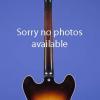"The Only Mid-1970s Thin-Line Gibson with Dots"
This rare guitar weighs 7.50 lbs. and has a nut width of slightly under 1 9/16 inches and a standard Gibson scale length of 24 3/4 inches. Single-bound maple body, mahogany neck, and rosewood fretboard with 22 jumbo frets and inlaid pearl dot position markers. Headstock with inlaid pearl "Gibson" logo and pearl crown inlay. Individual "no-name" Gibson Deluxe closed-back tuners with white plastic oval buttons. Two Gibson mini-humbucking pickups with balanced outputs of 5.80k and 5.85k. The pots are dated "1377129" (July 1971). Black plastic pickguard. Four controls (two volume, two tone) plus three-way selector switch and jack socket, all on semi-circular black plastic control plate on lower treble bout. Black plastic ribbed-sided conical-shaped "Witch Hat" knobs with white markings and metal tops with black lettering. ABR-1 Tune-O-Matic retainer bridge and trapeze tailpiece with raised diamond on cross-bar. Serial number ("184359") and "Made in U.S.A." stamped on the back of the headstock. This guitar is a second, with a "2" stamped above the serial number on the back of the headstock. At one time Schaller tuners were on this guitar, but they have now been replaced with vintage-style Gibson Deluxe tuners, as per original. This guitar is in excellent plus (8.75) condition, with the absolute bare minimum of belt buckle scarring on the back of the guitar and a few tiny and insignificant surface marks. We would have easily have given this guitar a strong 9.00 had it not been for the changed tuners. Housed in the original Gibson black hardshell case with cream-colored fleece lining (9.00).
"[The] ES-325, essentially a budget 335, the only mid-1970s thin-line Gibson with dots. Details: maple body, one f-hole (a most unusual feature for Gibson), small humbuckings, no peghead inlay, bargain-basement pickguard. Mounting the controls from the top, a process resulting in the top-mounted cover plate, did not require the drilling of individual holes for the knobs and switch and thus helped lower production costs. Note that on Gibson's later thin-lines the body horns (cutaway bouts) are more pointed than those on the early dot-necks" (Tom Wheeler, American Guitars: An Illustrated History, p. 154).
Translate:

